What We’re Reading: Self-Portrait in Green

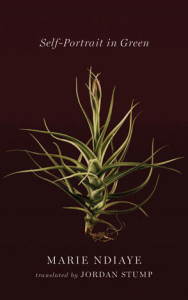 Self-Portrait in Green by Marie NDiaye, translated by Jordan Stump (Two Lines Press, 2014)
Self-Portrait in Green by Marie NDiaye, translated by Jordan Stump (Two Lines Press, 2014)
Marie NDiaye’s Self-Portrait in Green eludes genre, but is a work of prose, lyrical and elliptical as prose comes, rendered beautifully into English by Jordan Stump. Ostensibly a memoir, Self-Portrait focuses not on narrative, but on the women who shape the speaker. The book opens on an evening in December 2003 along the banks of the Garonne River, which is “rising hour after hour in the dark.” The Garonne, we’re told, can rise above its banks nine meters before it overflows:
We wait, we watch. The object of our vigilance is not some Old Man, it’s not le Mississippi, it’s not le Danube or le Rhône; no one here doubts for a moment that la Garonne’s essence is feminine. She’s brown tonight, heavy, almost bulging. (4)
The threat of a flood sets the tone for the following 100 pages, the possibility of violence just around the corner.
Throughout the book, NDiaye introduces a series of “green women,” among them are a woman standing under a banana tree, the speaker’s mother, and a woman who visits after hanging herself. Some of the women in green are friends, some strangers; all of them are an aspect of NDiaye. This obsession with identity—Who am I? Who is she? Who are we?—suffuses all of her work. Her short story “The Death of Claude François” in the collection All My Friends (Two Lines Press, 2013) features what could be considered a quintessential NDiaye line: “And the woman who looked like Marlène Vador, and who was Marlène Vador, since she’d said so[…]” In Self-Portrait in Green passages like this come up several times:
That’s when I run into Christina, but as soon as I see her I’m not sure it’s her rather than Marie-Gabrielle or Alison. Not that her name escapes me: it’s just that, among those three women, I no longer know which this one is. (14)
I believe that the woman in green, who told me her name is Katia Depetiteville, is not Katia Depetiteville, and I believe that if I asked people in the village for a description of Katia Depetiteville they wouldn’t describe this woman, the woman in green. They’d describe a very different person. But the woman in green doesn’t know that. She sincerely and naturally believes herself to be Katia Depetiteville. And for what reason? Is it so that, at various moments in my life, I might meet up with a woman in green? Because this is only one among many. (25)
NDiaye’s focus on identity speaks to an existential threat of oblivion, more terrifying than the possibility of violence. We fear violence being done to us, but even more we fear being forgotten:
I remember a woman in green from my grade-school days. Tall, brutal, and heavyset, she promises us all a trip to prison if we eat too slowly, if we dirty our clothes, if we don’t raise our eyes to meet hers. […] Because of her, a pall of dread hangs over the school. She carries more than one child off toward a dark hallway, proclaiming that prison awaits at the far end, and cries of terror resound as that stout woman disappears with her little prisoners clamped beneath her green-sleeved arms. The children are never seen again. (11-12)
The fear of being forgotten goes hand in hand with the fear that life has no purpose. NDiaye, like her countryman, Camus, comes seems to come to the conclusion that life is meaningless and we will be forgotten. Her characters roll their stones up the hill and watch them roll back down, but NDiaye doesn’t come to Camus’ conclusion that they might be happy. Ultimately, this meaninglessness is another form of violence her characters are subjected to. NDiaye’s speaker asks, “Was I ever seen again?”
Early in Self-Portrait in Green, when the book’s speaker meets the woman she thinks might be Christina or Marie-Gabrielle or Alison, who tells her about something that has been seen around:
“A bunch of us saw it, in our yards, on the riverbank, in… Apparently there were even people who saw it in the schoolyard. The mayor… the mayor knows all about it. He saw it too. Something black, and quick. Oh, there were plenty of people who saw it. (18)
At the end of the book, NDiaye’s speaker hears children shouting and finds them gathered around “a dark form, moving and anxious” in the street. “The children ask if I saw it, if I can tell them the name of what they saw.”
“Time to come in now,” I say, shivering. “No, I don’t know what that’s called,” I tell them. “I don’t think it has a name in our language.”
There’s something sinister at the heart of Self-Portrait in Green, something intangible and frightening. If asked what it is I would answer as NDiaye does: I don’t think it has a name in our language, whether that’s NDiaye’s French or Stump’s English. With a long list of accolades to her name, NDiaye is surely a writer to reckon with, though too few of her works have been translated. Let’s hope that Stump and others continue to bring her bewildering prose to the English-speaking world.
What other writers are producing brilliant work, but not yet reaching an English-speaking audience?
What We’re Reading: If the Tabloids Are True What Are You?

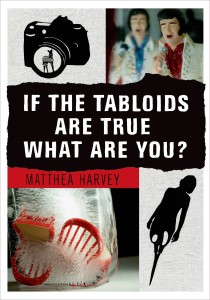 If the Tabloids Are True What Are You? by Matthea Harvey (Graywolf Press, 2014)
If the Tabloids Are True What Are You? by Matthea Harvey (Graywolf Press, 2014)
Matthea Harvey is a rare poet whose work is at once technically sound and formally innovative, original, and moving. If the Tabloids Are True What Are You is her fourth collection and all of her themes and obsessions are on display, careening into one another to create a hybrid work featuring a cast of hybrid characters. The book itself is lovely to look at, filled with original visual art that is synthesized beautifully and seamlessly with the text.
Visual art isn’t new for Harvey: she created the cover image for her 2007 collection Modern Life (Graywolf, 2007), collaborated with painter Amy Jean Porter on a collection of erasures called Of Lamb in 2011 (McSweeney’s), and her sister is the visual artist Ellen Harvey. The difference between her previous work and Tabloids is how closely tied the art and text are. A series of nine poems only have images as titles:


Another four have text cut into silhouettes as titles:

One piece,
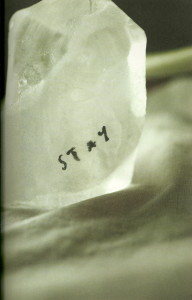
(d)evolves beyond even those and features no text, except the word “stay” in the title.
A poem early in Tabloids, “Michelin Man Possessed by William Shakespeare,” could be read as an ars poetica of hybridity. “I’ve taken many forms over the years, / but this may be the strangest one,” this perfect Elizabethan sonnet begins. Harvey loves taking new forms, inventing impossible or impractical machines. Indeed, her second collection is called Sad Little Breathing Machine (Graywolf, 2004). The final couplet of “Michelin Man Possessed by William Shakespeare” is most apt when talking about Harvey’s work:
Make us a man, or make us a machine—
But do not leave us trapped here in-between.
Whether Harvey fears or loves liminal spaces is hard to know, but she spends a lot of time in them. In only the first 20 pages, Harvey combines visual art with text to create a new form, which takes for its subject a composite being, the mermaid–part human, part fish. The text of these pieces are prose poems, a hybrid form itself.
The standout piece in Tabloids is the long closing piece, “Telettrofono,” a mixture of history, poetry, visual art, and, in one iteration, sound. The piece “was originally created as a soundwalk with sound artist Justin Bennett for Stillspotting NYC: Staten Island.” In this masterpiece, Harvey’s obsessions spiral into and around one another. Using the life of inventor Anonio Meucci, Harvey crafts for him a mythology, using his real life achievements to build a world where mermaids come to land for the love of sound. In Harvey’s narrative, Meucci’s mermaid wife, Esterre, inspires his inventions. The small details that make the piece:
PRESET PATENT MODE
MARINE TELEPHONE: WAY FOR THOSE THAT WORK UNDERWATER CALLED DIVERS HELPED BY THE TELEPHONE TO SPEAK ABOVE WATER (PATENT STILL PENDING AT TIME OF DEATH)
PRESET MARINE TELEPHONE MODE (MERMAID CHORUS)
Calling us “divers
is probably a good idea.
The fusion of invention, history, hybrid creatures, visual art, and text is remarkable and poignant.
Despite all of the crossbred forms, the poems collected here demonstrate Harvey’s command of technique. As off-kilter as her subjects can be, she still knows how to craft a poem that is surprising and complete. The sonnet mentioned earlier is impressive on its own, but other poems feature well placed revelations that drive the poems forward. The opening “Mermaid” poems create a new mythology of mermaids:
“At least she’s all mermaid: never gets tired of swimming, hates the thought of socks.”
(“The Straightforward Mermaid”)
“These days, her sisters trail cruise ships, hunting for orange prescription bottles that might be bobbing in the ship’s wake.”
(“The Impatient Mermaid”)
“Mer-funerals are the worst since, poof, the merfolk just morph into seafoam.”
(“The Morbid Mermaid”)
Because, of course mermaids dissolve into seafoam when they die. Of course they’re addicted to lost Xanax and hate socks. Again, it’s the small details that elicit small gasps and surprised laughs that make these poems so exciting.
Whether Harvey planned it or not, she has been building up to If the Tabloids Are True What Are You? in all of her previous work. It’s still jarring and humbling to see how well deployed her craft is in this book. It makes me wonder what she’ll do next, where she can go from here. Based on her previous work, it’s sure to be a surprise.
What other writers currently working are at the top of their game right now?
What We’re Reading: House of Deer
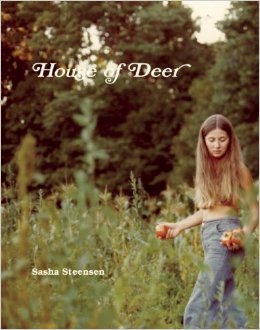 House of Deer by Sasha Steensen (Fence Books, 2014)
House of Deer by Sasha Steensen (Fence Books, 2014)
Sasha Steensen’s books are more lyric project than poetry collection. While many collections of poetry have themes that tie the poems together, Steensen’s books use their subject as a nexus around which the project grows, as if Steensen free-associated around the subject and developed individual pieces from there. House of Deer, Steensen’s intricate and lovely third collection, centers on her back-to-the-land childhood. Like her second collection, The Method (Fence Books, 2008), Steensen blends research and personal history through a process of addition, subtraction, and associative swerves.
House of Deer quotes, mentions, or makes references to Theresa Hak Kyung Cha, Gerard Manley Hopkins, George Oppen, and Baudelaire, among many others as a way to begin building (and it’s probable that this reader missed even more references). These connections are layered and reward repeated readings. The titular poem, “House of Deer,” mentions “the house on Hopkins Road,” where the reader assumes Steensen’s family lived; a later poem, “Fragments,” is noted as being written “after Hopkins.” This connection does not feel like an accident.
One of the more notable repeated references in House of Deer is Hart Crane, who was from Garrettsville, Ohio, where Steensen also grew up. His work and life become a starting point for Steensen to discuss familial tension, addiction, and self-destruction: “The family’s relationship with itself was strained. // This was meant to be a story about Hart Crane” (from “Fragments”). Later, Steensen quotes Crane (along with several other sources, all cited in parentheses in the text) in a piece called “Personal Poem Including Opium’s History,” which is dedicated to Steensen’s brother:
Instead, let’s talk about your closet full of weed.
If I could say sorry for that disclosure, I would.
But that’s too “the author-(to her brother)-to her book.”
Too Anne Bradstreet for me.
Yo-Ho! Sweet opium and tea (Hart Crane)
The Crane connection goes beyond a shared hometown. A “hart” is another term for a male deer; deer, like Crane’s life and work, serve as a way to enter into memory. Like deer, Steensen lived on the fringes—both of forest and mainstream culture—in a family unit that moved together: “sound of deer changing direction &then turning back,” as she writes in the section from which the book takes its name. Another section, “The Girl and the Deer,” is a retelling of a Zuni story. In it, Steensen tells “a story the writer cannot tell” of a girl, abandoned by her mother, being raised by a deer mother before her biological family kills her deer family and incorporates the girl back into their family.
Steensen’s method of composition could fall apart in any number of ways, but her attention to poetic lineage—the aforementioned references to Crane, Hopkins, et al—helps keep the project soaring (as it did in The Method). Further, Steensen displays a subtle attention to technique (learned, as she says in an interview with ZYZZYVA, from Crane). Take a standout piece like “A History of the Human Family:”
To find our First Family
what do we peer through,
what manhole or anthole?
what foxhole or portal?
what Afar Triangle?
It was 2.5 million years ago,
& it was eternal.
The intricate notice of sonic possibilities and meanings present here is found throughout the book adding a layer of complexity to the project that drives the reader forward.
Though Steensen’s method of composition may be very modern, she enters into dialogue with her influences and poetic-godparents. The effect is a complex, self-referential text that is as rewarding as it is difficult, which is to say very. Readers that enjoy layered poetic narrative will find a favorite author in Sasha Steensen.
What are your favorite “book projects,” as opposed to poetry collections?
What We’re Reading: Citizen: An American Lyric

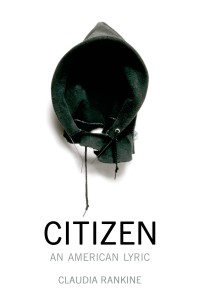 Citizen: An American Lyric by Claudia Rankine (Graywolf Press, 2014)
Citizen: An American Lyric by Claudia Rankine (Graywolf Press, 2014)
To this reviewer, it seems like we’re having a bit of a cultural moment, confronting issues of racism and sexism on a national level. In the publishing industry, organizations like VIDA and Cave Canem are making space for diverse voices and calling on more privileged individuals to sit down and listen. This is a good thing for readers whose options are growing as well made and challenging books are brought to the fore.
Back in August I reviewed Jamaal May’s Hum and wrote a little bit about how our reading is almost always affected by the world around us. I finished reading May’s book when protests in Ferguson began and, shortly after reading Claudia Rankine’s Citizen: An American Lyric the #Pointergate scandal hit and I found myself rereading Rankine’s words in light of yet another story with systemic racism at its core. I’m reading within this cultural moment, which has altered my reading list in profound ways.
Citizen contains a series of vignettes describing, in second person, various microaggressions—subtle, perhaps unintended, displays of power by white people toward people of color.
You are in the dark, in the car, watching the black-tarred street being swallowed by speed; he tells you his dean is making him hire a person of color when there are so many great writers out there.
So begins one such vignette. Another reads, in full:
The real estate woman, who didn’t fathom she could have made an appointment to show her house to you, spends much of the walk-through telling your friend, repeatedly, how comfortable she feels around her. Neither you nor your friend bothers to ask who is making her feel uncomfortable.
Rankine pulls news stories into these vignettes as well, referencing Don Imus, who notoriously insulted the Rutgers University women’s basketball team, and men (boys in the case of the last two) like James Craig Anderson, Trayvon Martin, and Jordan Davis whose tragic deaths were racially motivated.
This is poetry as documentary, as news story. At worst, poetry like this can feel dated, but Rankine has a knack for highlighting the stories that need to be remembered and turning them on us so that we see them differently. As a white man, the experiences of people of color are and always will be beyond my abilities to understand. Rankine, however, provides a window into a world I have the privilege of knowing nothing about. Rankine puts the reader in the spotlight, making us see these stories anew, as a way to cast these aggressions from her body. It’s a tactic that is potentially triggering to someone who has experienced aggressions like this, but is a way to discomfort the comfortable.
Beyond the content, Citizen is formally compelling as well, though very much in the tradition of American letters, as the subtitle alludes to. Split into seven parts, the book has no table of contents and only a single section features titled pieces. This gives the effect of an extended and single work. Walt Whitman’s Leaves of Grass, with its long, democratic lines, is a clear precursor, but Rankine’s work exists in the more contemporary space of lyric essay as well. Rankine uses outside text and images to illuminate and complicate, such as the recurring quote from Zora Neale Hurtson, “I feel most colored when I am thrown against a sharp white background.” This text stands out most as a two-page reproduction of Glen Ligon’s rendering of the quote in black on a white background. Indeed, Hurston’s quote can be considered a sort of theses statement for the whole book.
In what is perhaps the most focused and clear section, Rankine describes another series of microaggressions, these against tennis star Serena Williams. With the passion of a fan, Rankine examines some of the more egregious offences against Williams:
The most notorious of Serena’s detractors takes the form of Marina Alves, the distinguished tennis chair umpire. In 2004 Alves was excused from officiating any more matches on the final day of the US Open after she made five bad calls against Serena in her semifinal matchup against fellow American Jennifer Capriati. The serves and returns Alves called out were landing, stunningly unreturned by Capriati, inside the lines, no discerning eyesight needed. Comentators, spectators, television viewers, line judges, everyone could see the balls were good, everyone, apparently, except Alves. No one could understand what was happening.
[…]
Though no one was saying anything explicitly about Serena’s black body, you are not the only viewer who thought it was getting in the way of Alves’s sight line.
Notice that Serena’s detractors take form as a particular person, a shape for these events to exist in. This is the power of literature, to distill a lifetime of small frustrations into one body that will carry and enact those frustrations on the page. The “form” is a way of focusing the reader’s attention on an event and asking the reader, as Rankine writes later in the book, “What do you mean? // Exactly, what do you mean?”
After reading Hum I asked if Poetry Can Save The World or, at the very least, ease your pain when the news of the world becomes too much. I ask both questions again now in the context of Citizen. Reading is an act of empathy, especially if the text you’re reading is in second person, as Citizen is. Can poetry like this save the world?





